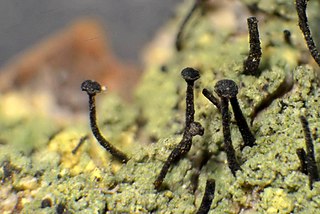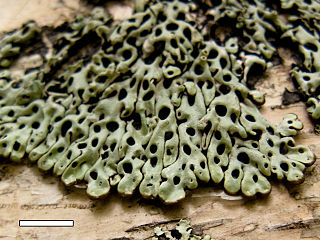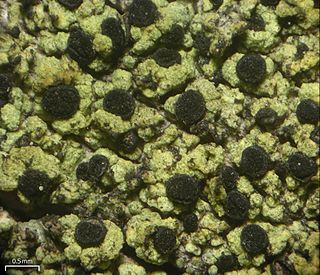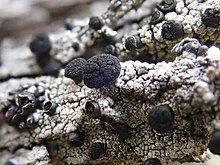
The Collemataceae are a lichenized family of fungi in the order Peltigerales. The family contains ten genera and about 325 species. The family has a widespread distribution.

The Physciaceae are a family of mostly lichen-forming fungi belonging to the class Lecanoromycetes in the division Ascomycota. A 2016 estimate placed 19 genera and 601 species in the family.

The Mycocaliciaceae are a family of seven genera and about 90 species of fungi in the order Mycocaliciales.

Calicium is a genus of leprose lichens. It is in the family Caliciaceae.
Everniopsis is a fungal genus in the family Parmeliaceae. It consists of a single species, the bark-dwelling lichen Everniopsis trulla, which occurs in Africa and South America.

Leptogium is a genus of lichen-forming fungi in the family Collemataceae. It has about 110 species. Species formerly classified under Leptogium have since been divided among the genera Leptogium, Pseudoleptogium, and Scytinium. Leptogium lichens are predominantly found on tree bark or soil, often among mosses, and sometimes on rocks in moist environments.

The Caliciaceae are a family of mostly lichen-forming fungi belonging to the class Lecanoromycetes in the division Ascomycota. Although the family has had its classification changed several times throughout its taxonomic history, the use of modern molecular phylogenetic methods have helped to establish its current placement in the order Caliciales. Caliciaceae contains 36 genera and about 600 species. The largest genus is Buellia, with around 300 species; there are more than a dozen genera that contain only a single species.

Menegazzia is a genus of lichenized fungi containing roughly 70 accepted species. The group is sometimes referred to as the tree flutes, honeycombed lichens, or hole-punch lichens. The most obvious morphological feature of the genus is the distinctive perforations spread across the upper side of the thallus. This makes the group easy to recognise, even for those not particularly familiar with lichen identification.

Calicium viride, commonly known as the green stubble lichen, is a species of pin lichen in the family Caliciaceae, and the type species of the genus Calicium. It is a common and widely distributed species in temperate areas of the Northern Hemisphere and southern South America.

Allocalicium is a lichen genus in the family Caliciaceae. It is monotypic, containing the single pin lichen species Allocalicium adaequatum.
Pseudothelomma is a genus of crustose pin lichens in the family Caliciaceae. It currently contains two species. The genus was circumscribed in 2016 by lichenologists Maria Prieto and Mats Wedin. The generic name Pseudothelomma refers to its resemblance to genus Thelomma, where the two species used to be classified. Both species grow on dry exposed wood, particularly fence posts.

Pyxine sorediata, commonly known as mustard lichen, is a widely distributed species of foliose lichen in the family Caliciaceae. It has a subtropical to warm temperate distribution, and grows on bark, rocks, and moss as substrates. Pyxine sorediata has been reported from regions of North America, Europe, Africa, Asia, and Australasia.

Scytinium is a genus of lichen-forming fungi in the family Collemataceae. It has 49 species. These lichens are typically found on basic rocks, soil, and trees, occasionally in association with mosses. Despite the morphological and ecological diversity within Scytinium, its species share similar ascospore features, such as shape and septation, as well as a small to medium-sized thallus with at least a partial cortex.

Lathagrium is a genus of lichen-forming fungi in the family Collemataceae. It has 10 species of gelatinous lichens. Species in this genus typically grow on calcareous rocks, often amidst mosses, but can also be found on siliceous or serpentine rocks, mortar, or soil.
Calicium carolinianum is a species of lichen in the family Caliciaceae. It is endemic to the Gulf Coastal Plain region of the United States. The lichen contains norstictic acid, and has ascospores that measure 13–17 by 8–9 μm.
Amandinea myrticola is a species of corticolous (bark-dwelling), crustose lichen in the family Caliciaceae. Found in Portugal, it was formally described as a new species in 2011 by Mireia Giralt, Pieter van den Boom, and John Elix. The type specimen was collected by the second author from the south side of Barragem de Odivelas (Alentejo); the lichen has also been recorded from another locality in Alentejo. It grows on the smooth bark of Myrtus communis and Pinus twigs. The thallus of the lichen is a smooth to lightly wrinkled grey crust, lacking a prothallus. Amandinea myrticola produces ascospores of the Physconia-type, characterised by a thick septum and median wall thickenings. They are ellipsoid in shape, and typically measure 11–13.5 by 5–6 μm. The lichen does not make any secondary compounds that are detectable with standard chromatographic techniques, and all reactions to standard chemical spot tests are negative.

Calicium pinicola is a species of lignicolous (wood-dwelling), crustose lichen in the family Caliciaceae. It is widely distributed in Europe, and also occurs in the United States.

Solorina crocea, commonly known as the orange chocolate chip lichen, is a species of terricolous (ground-dwelling) and foliose (leafy) lichen in the family Peltigeraceae. The lichen, which was first formally described by Carl Linnaeus in 1753, has an arctic–alpine and circumpolar distribution and occurs in Asia, Europe, North America, and New Zealand. It generally grows on the bare ground in sandy soils, often in moist soil near snow patches or seepage areas. Although several forms and varieties of the lichen have been proposed in its history, these are not considered to have any independent taxonomic significance.
Pertusaria galapagoensis is a species of corticolous (bark-dwelling), crustose lichen in the family Pertusariaceae. Found on the Galápagos Islands, it was formally described as a new species in 2015 by Elix, Yánez-Ayabaca, A.W.Archer & Bungartz. The type specimen was collected on Floreana Island at an altitude of 371 m (1,217 ft), where it was found growing on the bark of a south-exposed trunk of Cedrella odorata. The species epithet refers to its distribution.













